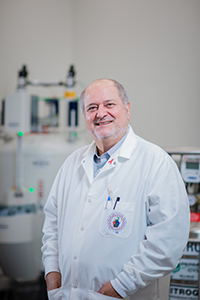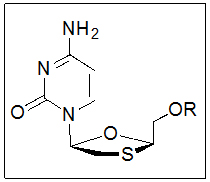Organic medicinal chemist and virologist Raymond Schinazi, PhD, the Frances Winship Walters Professor of Pediatrics at Emory and director of the Laboratory of Biochemical Pharmacology, was born in Egypt to Italian parents. In 1962 his family was threatened by the Nasser regime and immigrated to Naples as refugees. He went to boarding school in the UK, where he was a chemistry major at Bath University, and later came to the U.S. and studied pharmacology at Yale University before beginning his career at Emory.
The path to chemist: I was actually pretty good at chemistry. I wanted to by a physicist, but because of my background coming from a Middle Eastern country, I couldn’t really walk into a nuclear reactor and work on radiation, bombs, and things like that. I was very talented in physics but I got blocked from doing this because of my circuitous route, going from an immigrant, to a British student, and then an American student. So basically, I had no choice but to go into chemistry. It ended up being a good choice for me, though, since I worked on natural products first, and subsequently on nucleosides, which are basically the building blocks for DNA and RNA. If you think about it, just about every virus on this planet has DNA or RNA.
 My mentor: At Yale, I worked with William Prusoff (“the father of antiviral chemotherapy”), who developed the first drug for herpes of the eye. When I started my career at Emory in 1978, I was working on combination chemotherapy drugs for herpesvirus. Unfortunately, at the time, even for herpes, people didn’t believe in combination therapy for viruses. We already had combinations for TB and cancer, but nobody believed you needed them for viral infections.
My mentor: At Yale, I worked with William Prusoff (“the father of antiviral chemotherapy”), who developed the first drug for herpes of the eye. When I started my career at Emory in 1978, I was working on combination chemotherapy drugs for herpesvirus. Unfortunately, at the time, even for herpes, people didn’t believe in combination therapy for viruses. We already had combinations for TB and cancer, but nobody believed you needed them for viral infections.
Academia versus industry: I’ve always been in academia, never had a real job in industry, trained in industry but I never actually took a job with a salary from industry, ever ever, but I also realized rather quickly academia is not a great place to develop drugs once you’ve discovered them.
Proudest career moments: Our background in nucleoside chemistry propelled us to the front of the line, and laid the foundation for what we know today. We were the first to, for example, set up the first HIV lab at Emory University. At the time, we didn’t know too much about HIV. We didn’t know if it was a respiratory virus, we didn’t know if it would affect us personally. But we worked on it because there was a need and an urgency. When you’re young, you want to save the world. We took the gamble and it paid off.

3TC Chemical Structure
I worked with Dennis Liotta for several years developing antiretroviral agents. Probably one of the most successful was FTC (emtricitabine), a very powerful anti-HIV drug that’s used widely in many drug combinations today for HIV. About 94% of people with HIV take one of our drugs invented at Emory. The other drug was 3TC (lamivudine). This led to a whole plethora of compounds. Subsequently we moved on to Hep B, because we found that some of our HIV compounds were also effective against it, killing two birds with one stone.
A lot of scientists discover things that sit on a shelf. I couldn’t tolerate that so I took the risk to move the compass, even using my credit card, to be able to form companies like Pharmasset, that became hugely successful and eventually sold for $11.4 billion—that’s billion with a “b” not an “m”. The company sold 13 years after being founded, that’s pretty fast. There were a lot of bidders, a lot of interest. Today our drugs are widely used and have saved millions of lives. When I wake up in the morning, I’m really happy to have saved so many lives. Not only me, but also my collaborators, we all worked together on this, industry, academia, advisers, consultants, medical teams, everybody was involved in this. Success is not really measured by the amount of money you make, it’s by the lives that you save.
Advice to young scientists: Keep trying, I have failed many times. I have drawers full of grants that never got funded. If you have a good idea, follow your heart and follow your brain and be stubborn and persist and you’ll get the funding.
Meeting people saved by your drugs: My cousin died of HIV in 1990 and it was devastating to me. A patient—a person I should say, because they’re not patients anymore—who takes our drugs has the opportunity to live longer. When they are revived, it changes everything for them. It’s like going to church and getting a wafer, you’re saving them in more ways than one. The (antiretroviral) drugs saved our florist’s boyfriend, and I get a lot of flowers for very cheap.
Fun fact: I’m an avid fisherman, I enjoy catching trout in North Georgia as well as deep sea fishing. Catching a fish is very similar to developing a drug, you throw in the bait, you hope a big fish hooks it, and then you have to reel it in. You’ve gotta realize the fish is there.
Go here to watch the stories of those involved and those who benefited from the discovery of 3TC & FTC. Go here to read the full series of blog interviews with inventors, patients, and others.